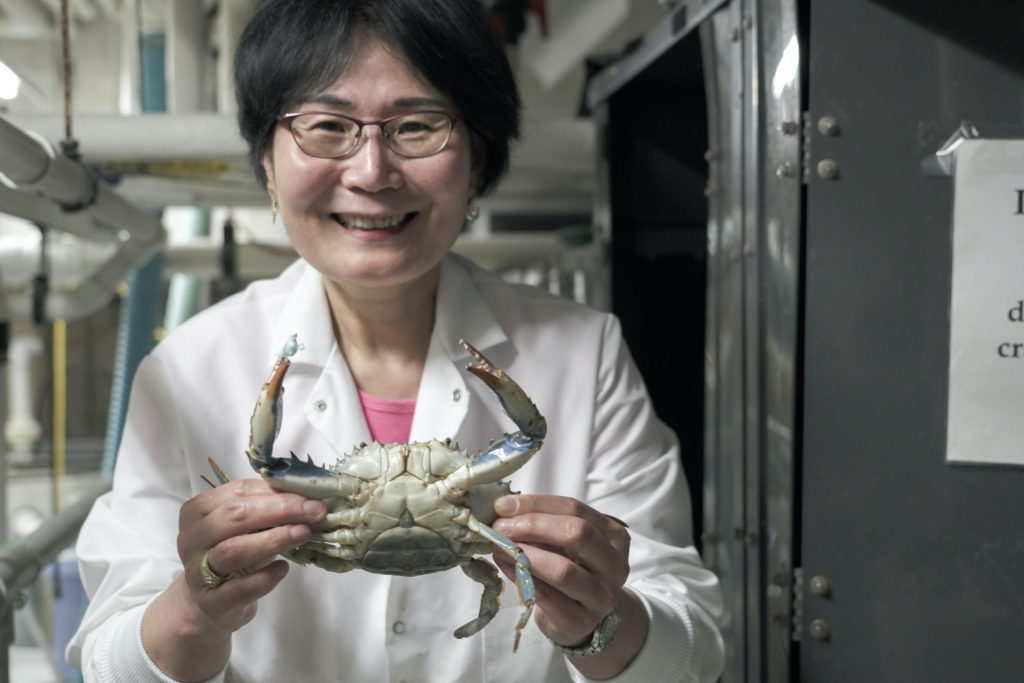Just when you thought you knew all there was to know about the Chesapeake Bay’s beloved blue crab, scientists have cracked the crab’s genetic code. They now have a complete picture of the crab’s DNA, opening the door to better research to keep the fishery healthy.
The University of Maryland Center for Environmental Science (UMCES) announced that Professor Sook Chung, an expert in crab biology at the Institute of Marine and Environmental Technology (IMET), which sits next door to the National Aquarium in Baltimore, led a three-year effort to sequence a crab’s genome.
UMCES explains the crab’s genetic blueprint can reveal which genetic traits make some crabs especially effective at reproducing or why some are better adapted to water temperatures warmed by climate change. This insight will ultimately help keep the crab population in check.
“Marylanders love crabs, and everybody wants to have big, fat crabs in the fall. Understanding what makes them successful is located in the chromosomes,” says Chung. “Knowing the full genome, we are several steps closer to identifying the genes responsible for growth, reproduction, and susceptibility to disease.”
Further, the genome’s ability to offer reproductive information could open the door to blue crab aquaculture. And the genetic blueprint could possibly even help track the source of crabmeat—whether it’s from Venezuela or the Chesapeake Bay.
So how did Chung and her team sequence the crab’s DNA? To begin, they chose the best possible sample crab. In October 2018, Chung went out on a crabber’s boat and gathered young female blue crabs to breed at IMET. One of the grew to adulthood, mated, and successfully produced offspring, proving she had “good genes”. They chose one of her baby crabs, also a female, for sequencing and nicknamed her “The Chosen One”.
The DNA was isolated and the genetic code was sequenced by a special computer, which had to run day and night for more than six months in order to correctly order the code.
Here’s how IMET explains that process:
“Imagine you take several volumes of an encyclopedia and you have a hundred copies of each volume. You put them all through a paper shredder and then you have to use that to reconstruct the original volumes of the encyclopedia,” said Associate Research Professor Tsvetan Bachvaroff, who was responsible for assembling the blue crab genome. “Once the encyclopedia, or genome, is back in the correct order, you can begin to identify genes and use it like a reference book, looking up genes to answer questions.”
The blue crab has between 40 and 50 chromosomes, nearly double the amount found in humans, and contains about 24,000 genes, making it diverse.
Researchers determined that the blue crab had between 40 and 50 chromosomes, which is nearly double the amount found in humans. However, these chromosomes were very short, resulting in a genome that is approximately one third the length of the human genome, in terms of bases. Despite its relatively diminutive size, the blue crab genome is rich in gene diversity, containing approximately 24,000 genes, slightly more than the amount identified in humans.
A group of local philanthropists “who are passionate about science, the Chesapeake Bay, and the blue crab” helped fund this project, led by private donors Mike and Trish Davis.
“Sook’s enthusiasm for this work was contagious, and we were thrilled to discover that the skills and technology for this exciting project existed right here in Baltimore,” said Mike and Trish Davis, who led the private effort to fund the project. “Her analogy of requiring a ‘blueprint’ for the blue crab, to really understand it—just like builders use blueprints to understand a building —clearly resonated with the donors, and we all really wanted this scientific milestone achieved here in Maryland.”
–Meg Walburn Viviano




